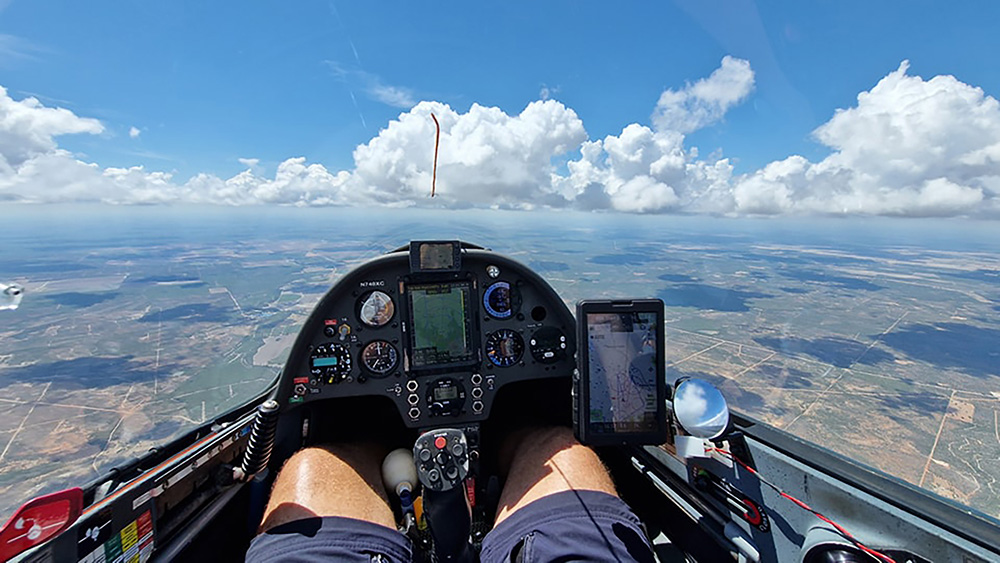
ABOVE: Adam Woolley cruising on course.
With contributions and photos from Adam Woolley, Matthew Scutter, Lumpy Patterson, Keith Gateley and Ronald Tabery
The World Gliding Championships in Open, 18m and 20m Multi Seat classes took place at Uvalde in August. Uvalde is located in the Texas Hill Country in South Texas 130km west of San Antonio and 87km east of the Mexico-United States border. It is in a vast landscape at a similar latitude north of the equator as Lake Keepit is south. Surrounded by low hills and plateaus, it is a legendary open country soaring site.
The Texas Hill Country sits in between the American Southwest and Southeast with weather influences coming from all over the continent. Powerful sea breezes are sucked far inland from the long stretch of the Gulf of Mexico and meet air flowing east from the mountain ranges to the west. Huge thunderclouds form with the potential for powerful squall lines and tornadoes. Cumulus can fill the sky from horizon to horizon, but the large distances ensure that the weather in the task area is never uniform.
The championships took place in high summer when temperatures on the ground were regularly 40 degrees and more. Not surprisingly, large tasks for all three classes were set on 12 racing days. This contest was a test of stamina, pace and planning as well as soaring skill. The Australian team, who are all used to similar conditions back home, were hoping to perform well – and they did.
Following are my observations following the race tracking and online, plus excerpts from the pilots' experiences as they reported them during the competition.
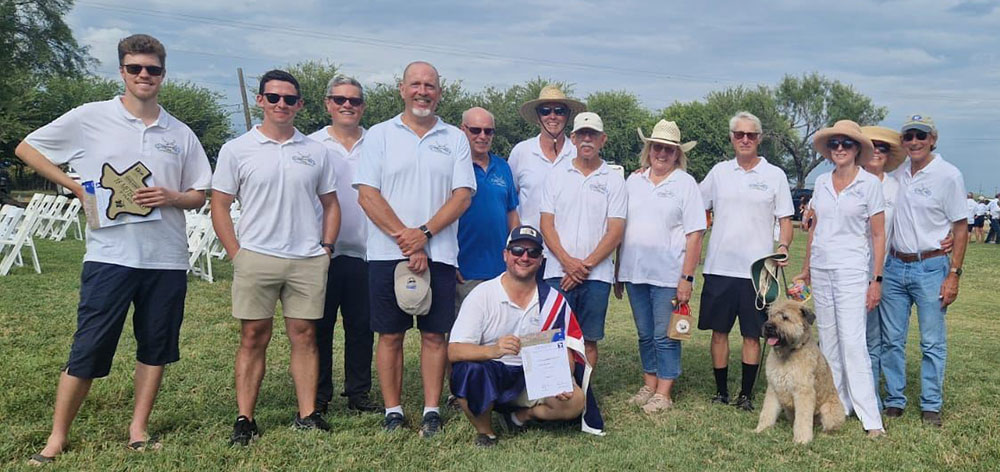
Matthew Scutter , Dylan Lampard , Keith Gateley, Lumpy Patterson, Ron Gleason, Adam Woolley, Geoff Brown, Jorgren Thomsen, Amanda Brown, Ron Tabery, Evie Tabery (team mascot), Gena, Melissa Garnet, Craig Garnet
Pilots from 24 countries flew in the competition. Australia was represented by five pilots - Geoff Brown in Open class, Matthew Scutter and Lumpy Patterson in 18m class and Adam Woolley with Keith Gateley flying in 20m Multi Seat class.
After a week of practice, the first day of the contest finally got underway. The Open Class gliders had a 528km racing task, with a 533km task for 18m class. Multi Seat class had 530km nominal Assigned Area Task. These big tasks on the first day demonstrated that Uvalde was a great site for a big wing championships.

The grid at Garner Field in Uvalde, Texas
A Marathon, Not a Sprint
On the second day, 500km-plus tasks were once again set, which emphasised that this was going to be a marathon, not a sprint, with the prospect of many long days in the air to come with very hot conditions on the ground.
Lumpy Paterson won his first podium spot at a WGC taking 3rd place in 18m class. Matthew Scutter came equal 4th. Adam Woolley and Keith Gateley also performed strongly, taking 4th place in Multi Seat class.
New Gliders in Open Class
Geoff Brown scored 855 points for the day in his JS1 while Claudio Schmidt from Brazil was at the bottom of the table flying his interesting Nixus.
The Nixus is a one-off glider designed by Brazilian aerospace engineer Professor Paulo Iscold. He built the Nixus Project sailplane with help from his students at California Polytechnic State University. It is a 28m glider with a 53.3 to 1 aspect ratio, and Fly By Wire ailerons.
Apart from the Nixus, all the other gliders in Open class were JS or EB gliders. The new JS5 had its first outing at a WGC with four of them flying in the class. Attie Jonker was of course flying a JS5, his newest creation. There were also five EB29Rs flying, and the remaining competitors all flew JS1s.
While this championships was clearly going to be a display of how these gliders performed against each other, it is not just the performance of the machine that determines the outcome, but the pilots as well. Many top WGC pilots were at Uvalde, including reigning World Champion Felipe Levin and fellow German and previous World Champion Michael Sommer, both flying EB29s.
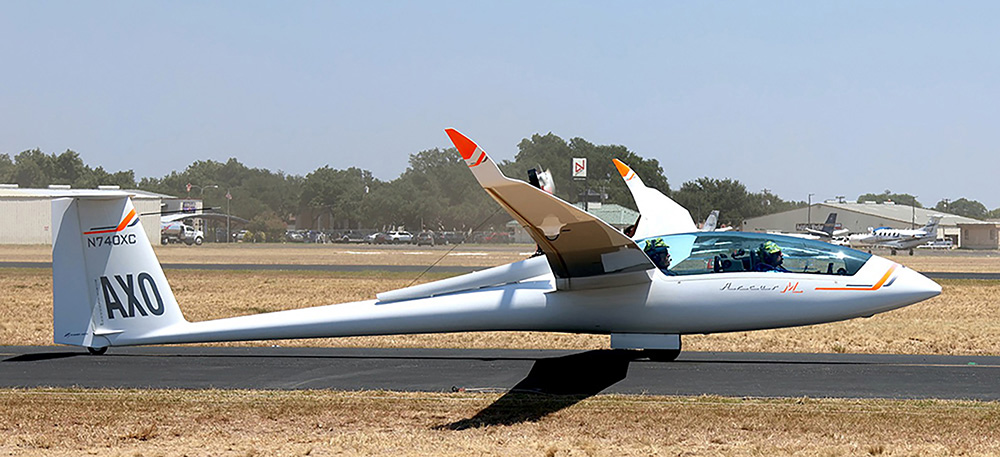
Adam Woolley and Keith Gateley taking off.
Day Win for Adam Woolley and Keith Gateley
After a long wait to launch the grid due to the day’s slow start, the gliders were launched at what seemed to be the latest time possible, while still leaving enough time to complete the race before the end of daylight.
The contest director would have been under considerable pressure to hold a race. It was a WGC, after all. But the tasks were clearly going to take right up until sunset and it was therefore uncertain if they were feasible.
The Open class pilots were the first to set off on track. They left as soon as the start gate opened. Most of the class soon found themselves below 2,000ft AGL. At the end of the day, six of the Multi Seat class had started their motors. Everyone landed about 15 minutes before sunset.
Adam and Keith won their class with a speed of 111.77 kph over a task of 448.44km. Coming home from the south, with weak climbs late in the day, looked difficult as the gliders struggled to find the last climb to final glide.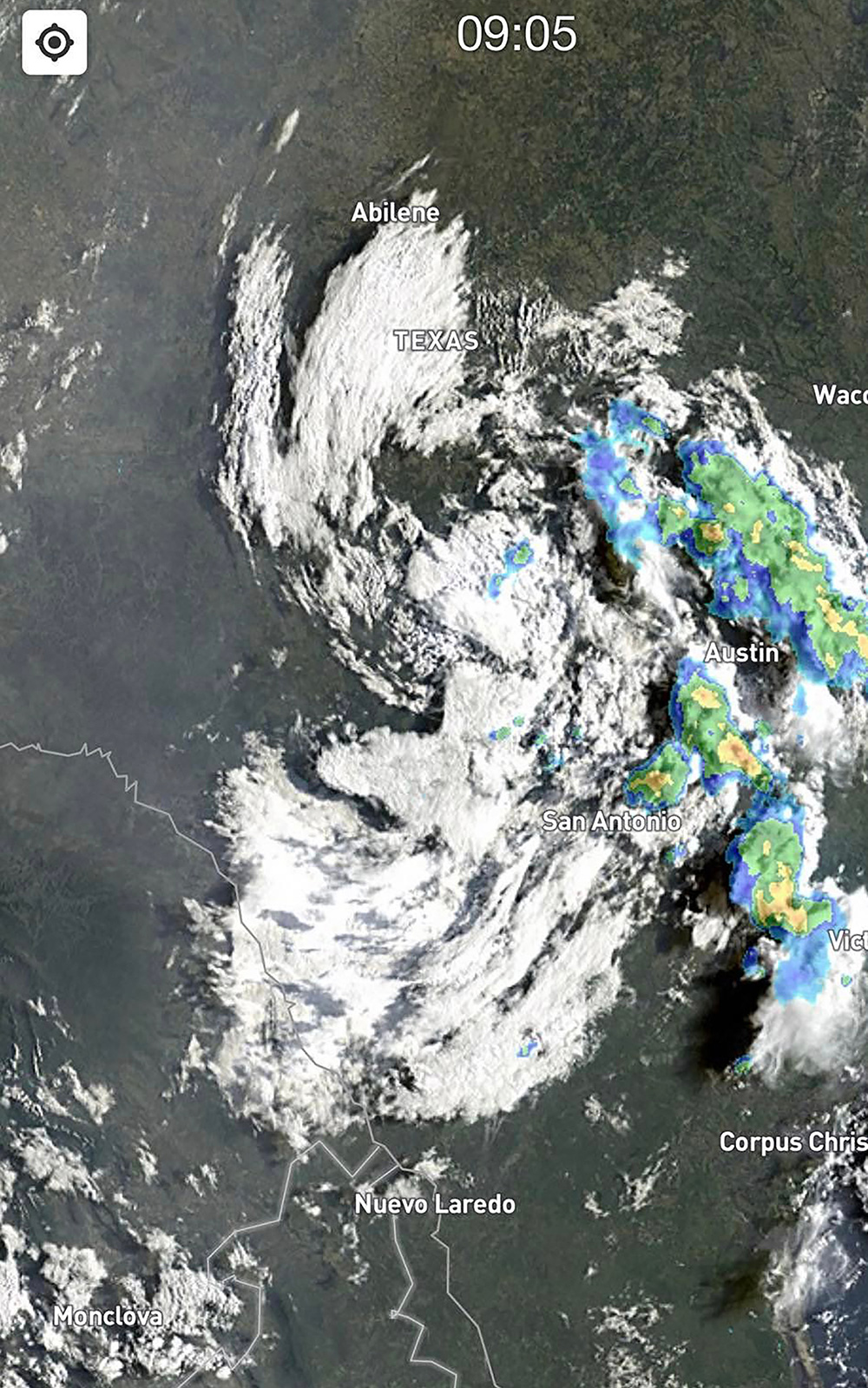
The satelite image on SkySight 28 August showing major development and showers.
Changeable Weather
For Race 5, the Multi Seat class was sent on a 4-hour Assigned Area Task. The live tracking showed climbs were averaging a consistent 4 to 6kts to over 8,000ft. Adam and Keith came home in 3rd place – the first of three podium positions in a row for them, making four in total for the contest.
However, after a good race the day before, the weather for Race 6 was challenging. It was a low and slow day, but Adam and Keith completed the 623.25 km task at 104.01 kph finishing the day in 13th place.
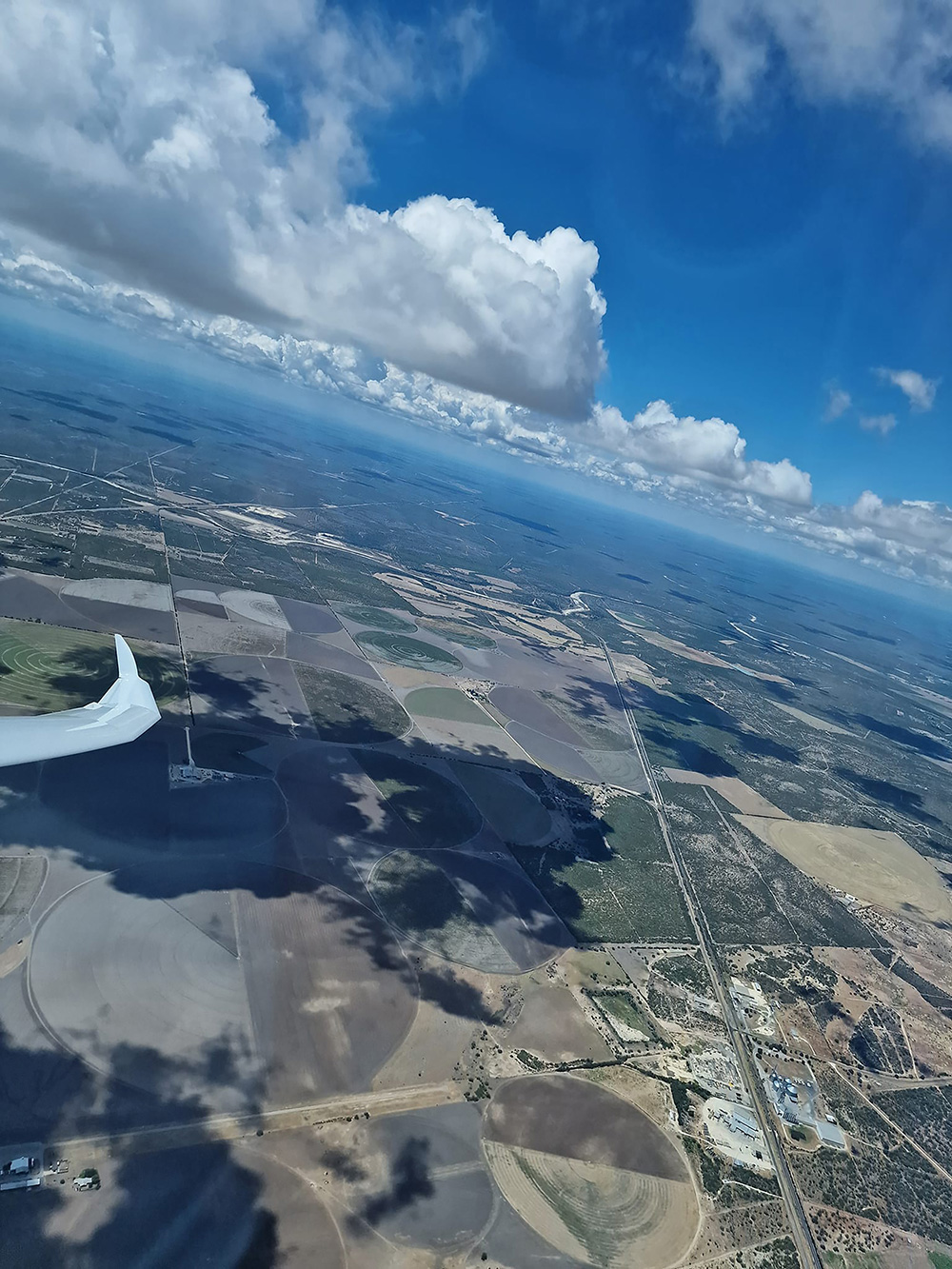
Flying over open country.
Day Win for Lumpy Patterson
Lumpy Paterson won Race 6 in 18m Class flying the 435km task at 125.3 kph for his first Day Win at a WGC. This was a great result but after finishing well down the table during the previous days, his overall score was off the leaders.
Meanwhile, Matthew Scutter had finished in the top 10 on four days with a highest placing of 4th for Race 2. Nevertheless, he was within reach of the leaders, demonstrating that consistency is the key to staying near the top of the table.
On the Podium Again
Race 7 went well again for Adam and Keith in Multi Seat. They finished in 3rd position flying 407.66km at 149.71 kph. After Race 8 the next day, Adam and Keith were back on the podium, this time in 1st place for their second Day Win.
Lumpy also had a good day, taking 3rd place in 18m class for his 3rd podium position in the contest. Matthew was just behind him finishing 4th flying 553.30km 153.91 kph.
The championships were clearly difficult, but what distances and what speeds the competitors had been achieving! However, the next day was a forced rest day due to adverse weather.
Looming Storms
With just three racing days to go, the jostle for podium positions was hotting up. Everything was to play for, but the weather for the final days was looking difficult. The pilots at the top of the table would not have wanted to take any chances and did not want the weather to turn the race into a throw of the dice. But, by the time the gliders started launching for Race 9, rain could be seen in the distance.
After the launch, storms loomed up from the east and headed straight for the task area. Staying in the air, avoiding rain, turbulence and strong wind became the only tactic.
Many gliders, even those with engines, were forced to outland due either to severe weather or to running out of fuel. One glider was forced to land in a lake. The landing and evacuation went well, but when local ranchers attempted to retrieve it from the water, the electrics caught fire and they pushed it back in.
Adam and Keith completed 131km scoring 213 points. The highest score for all classes was achieved by Claudio Schmidt in the Nixus, flying 341km and gaining 671 points. On some days, there is no substitute for span. Thankfully, there were no accidents or injuries.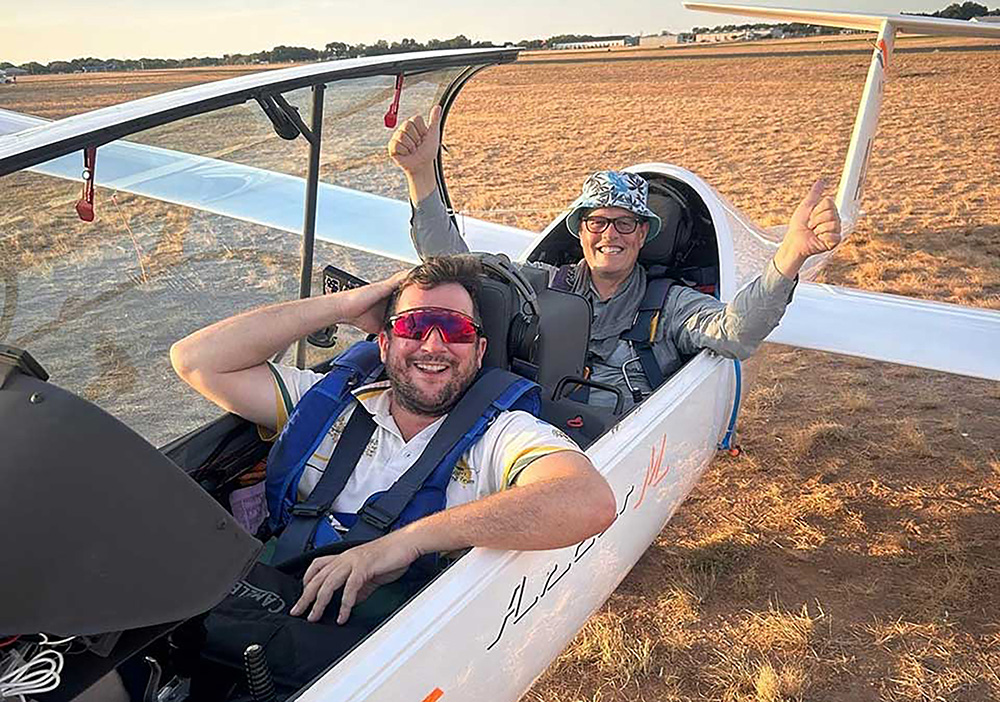
Adam Woolley and Keith Gateley after landing and winning Race 7.
Penultimate Day
Matthew Scutter finished Race 10 in 8th place, gaining 914 points that kept him close to the leaders, but it would have taken an epic fail on the last race for Matthew to have ended up on the final podium.
Adam and Keith finished in 9th place, keeping them just out of a podium position with one final race to go.
Champions Declared
The final race gave Matthew his first ever Day Win at a World Gliding Championship. He gained 1,000 points to finish in 5th place overall. Lumpy finished in 16th place but, with three podium positions under his belt, he had much to be proud of.
No one was able to challenge the near faultless performances of German pilots Stefan Langer and Simon Schröder, who took 1st and 2nd places in 18m class. Christophe Abadie, France and Jeroen Verkuijl, Netherlands were also ahead of Matthew in a fiercely fought contest.
In 20m Multi Seat class, Adam and Keith came 5th in the final race, finishing in 4th place overall just 15 points behind Lutz and Janowitsch, Austria in 3rd, Rubaj and Matkowski, Poland in 2nd and Arnold and Striedieck, USA – the new World Gliding Champions.
In Open class, Geoff Brown had been flying well against the best competitors in the world. At the end of the contest he had scored 7,176 world championship points, a great achievement.
All the members of the Australian team, on both the flying and organisation sides, did a fantastic job representing the country. They travelled across the world and competed with the best there are are in extreme conditions. Three cheers to them all.
Sean Young
Adam Woolley Racing
Race 3 – 20 August – Day Win
We had a late change of task on the grid, and calculated the gate to open at 15:30. No big deal, right? - except that it was a 3hr 45min AAT and that the end of thermals was predicted to be at 19:00, which turned out to be exactly correct. It was one very long final glide from altitude to across the line at 19:40 with the end of daylight declared for 20:00. Great to be home, that's for sure!
We just played the tactical and gaggle game today. Then, at all the key points, we were fortunate to feel brave and lead out. The last time we were high, we thought we had cooked it, because we were totally alone and had no idea what the target climb rate was. It turns out we were only slightly better off than the gaggle.
We caught a 2kt climb at approximately 2,500ft AGL, which built into 3 – 4kts. The gaggle quickly joined us from below. The climb petered out and we pushed into wind, got another surge, almost passed it up, but took an exploratory turn, which turned into 4kts and up another 2,000ft we went!
This was the decisive moment that kept us on top and in control. Finally, we set off on glide at more than 2,000ft over glide on a 0.6kt MC, and home James we went.
Race 5 – 22 August – 3rd Place
The power of the mind is the key point behind today's flight. We started high, started first, powered down the first leg, knowing that the Americans were hot on our heels. On the second leg, however, lower and lower we went. I have this weakness that when I'm in front, I will do everything in my power to make sure that I don't stop unless it feels like a strong thermal and I can core it straight away. I desperately don't want to mark a climb for anyone and I'm not willing to reduce my cruise speed until I really have to.
Today, that was down to 1,700ft until I got a 5kt save. Though it wasn't enough, I could see the Americans catching me slowly and I was confident that they turned at the same point in the first sector.
After our recovery, I decided that the entire gaggle, including myself, was in the wrong part of the sky. Everyone was trying to be on the outside for extra kilometres, but I decided that I could go faster by getting closer to the trough, which was key for working climbs easier, and turning early to get into the deep cu quicker.
I ran the numbers and from about 2.5hrs out, I needed to average over 6kts in order to come home on time by hitting all the turnpoints at minimum from that point on.
Hammer time. For the first time this comp, I flew at close to 100% to catch up what I had lost and to try to win the day in another way. It felt great. Though I could've resigned myself to losing more points, through the power of the mind I took it all into my own hands and decided to get cracking.
Unfortunately, when leading team Netherlands and Hungary out on the 2nd last leg, I missed a climb that they got behind me, pulling 2,000ft on me that I couldn't get back. We finished 7km behind as a result, which cost us a few points, but unlikely the Day Win.
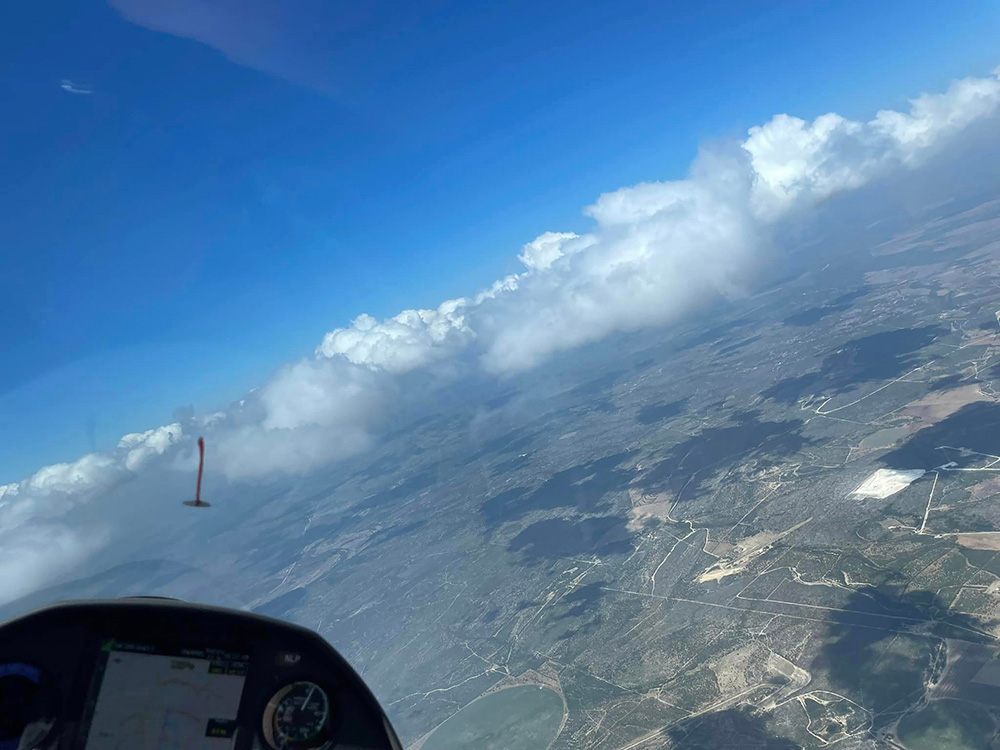
Race 7 – 24 August – 3rd Place
Even though we knew from the get-go it was an underset task, the organisers met the objectives in all reality. I do feel more rested going into the rest day tomorrow and the international evening tonight. As it turns out, the weather didn't keep booming until the end and I think we started at the very last optimum time – coming in a close 3rd and moving up to 2nd overall.
I'm really happy with how I'm flying. I'm confident and really happy/confident to do my own thing. This is partly because the weather here is very similar to Queensland, but also because of my team training and flying with Tobias Geiger. I'm not being influenced so much by the gaggle start games, just going when I think it's optimum and flying the process of a top flight, then accepting the results.
Today was climb and drive. Once I realised I could be going into a hole, I stopped in 5kts to top up, knowing it's neither fast nor slow.
Final glide was from 3 – 4,000ft below on a 3kt MC, but it was slightly nervous. I could've done better by taking a climb on the way, but it was all good learning. This site still has some tricks to be unlocked.
Race 8 - 26 August - Day Win
I've really enjoyed the last two tasks set by the organisers. We got in the air early and had an hour window to choose the optimum start for ourselves. Usually the first and last 15 minutes are slow, with the middle 30 minutes the choice window. The organisation is also using Pilot Event (PEV) for starts, which means that people – at least in my class – aren't mucking around like they would have been in the classic pre-start games.
We left our start late because it seemed to me that the conditions hadn't built up enough yet for racing. The word from the ground was that the gust front wasn't going to get to Uvalde for 4 hours and the conditions on the first glide weren't up to scratch.
During the latter part of the flight, we got lucky. The gust front didn't quite hit Uvalde until about 15 minutes after our arrival. We did park two cars behind our glider to protect it from unintentional ground loops. The wind got quite gnarly…
During pre-flight planning with SkySight, my general experience here saw us needing to max out every turnpoint. If there weren't random rain showers in the last, then I think I could've maxed the task and just finished on time.
It was a fun day out, very much like Australia. We won the day and were now 66pts off the top spot. There’s till a long way to go, and we need to keep doing what we're all (team 20 and AUS) doing.
Thanks to Dylan and Ron who were looking after ground ops perfectly. It's allowing me to be totally relaxed on the grid, knowing everything is being taken care of.

Lumpy Patterson out on track.
Matthew Scutter Racing
Race 1 - 18 August
I cracked the seal on WGC2024 with about 900 points for the day. I had made the perfect start into straightforward cu conditions, nearly catching the lead gaggle on the first leg, but pushed too hard to seal the deal and joined a climb they were marking too low, missing the bubble and having to take something weaker.
The rest of the day was spent playing catch up. Disappointing speed overall, even ignoring the earlier error – flight analysis showed I was having some trouble in the climbs, not getting the speed slow enough. It was probably just unfamiliarity at such high wing loadings. Hopefully by the end of the contest I’d get the hang of it.
Just squeaked home cleanly under the last dying cu.
Race 2 – 19 August – 4th Place
A highly unusual day today – almost every competitor was under time on the 4-hour AAT. The first turn was blue and weak, and most turned immediately towards the better conditions in later circles, even though the maximum remaining task speed was ‘only’ 160 kph. I was certain they were making a major error so I extended a bit further, but not too far in case everyone else had seen something huge that I hadn't.
After it became increasingly obvious we were all under time, I set myself on cruise control and enjoyed a leisurely guided tour from the amazingly talented Pôle France Planeur team. Watching the three (!) team pilots work together so effortlessly was incredible.
My extension in the first circle placed me well in the points, though less than I might have had if I'd had more faith in my own judgement.
Exhausted already after only two days but nearly 11 hours in the air. Ominous.
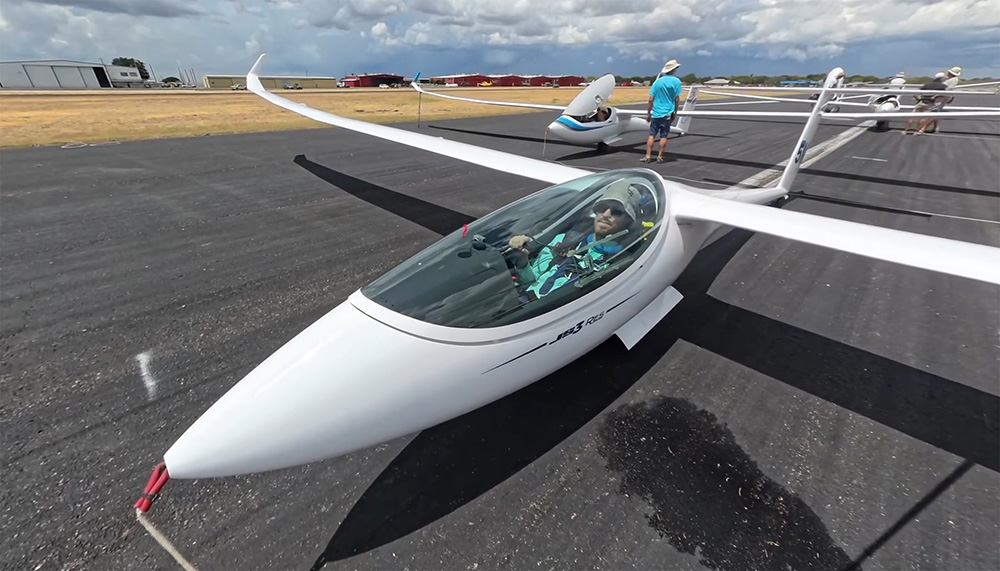
Matthew Scutter about to launch.
Race 3 – 20 August 5th Place
I got a lot of questions at briefing today - "Why does SkySight say the task is impossible?" - but I guess after 2 hours on the grid watching the sniffer, we got the answer.
The first task was... interesting 650km in the low blue starting at 2pm, but the B task was a 3hr 45min AAT with the gate opening about 3:30pm (end of thermals expected 6:30pm). So, let's see what happens.
We made it! We only got final glide from a bit of thermal wave on the top of the last climb. I had a very solid result, having started early, turned a bit further then joined the back of the gaggle and fought my way back to the front. A couple others did so as well but came further and will get a few points on me, but I'm pretty happy to have had an ultra-clean flight on a filthy task.
Hopefully we would see some changes to task setting tomorrow, given the entire fleet landed just before sunset!
Race 4 – 21 August – 5th place Which sector would you max out?
A lot of competitors chose the southern sector, perhaps anticipating the northern sector to be so ballistic as to run out of time, or perhaps concerned the forecast thunderstorms would make it unnavigable to the north later in the day.
Fortunately I had the ultra-high-def SkySight satellite pictures overlaid on the task in-flight and was able to clearly see the north sector was fast, but not too fast, and then turn short in the southern sectors for a very safe and easy 950-point flight, even after an atrocious start – twice falling out of the wave just before my PEV window.
I moved into third overall now. Will Stefan Langer ever get caught out?
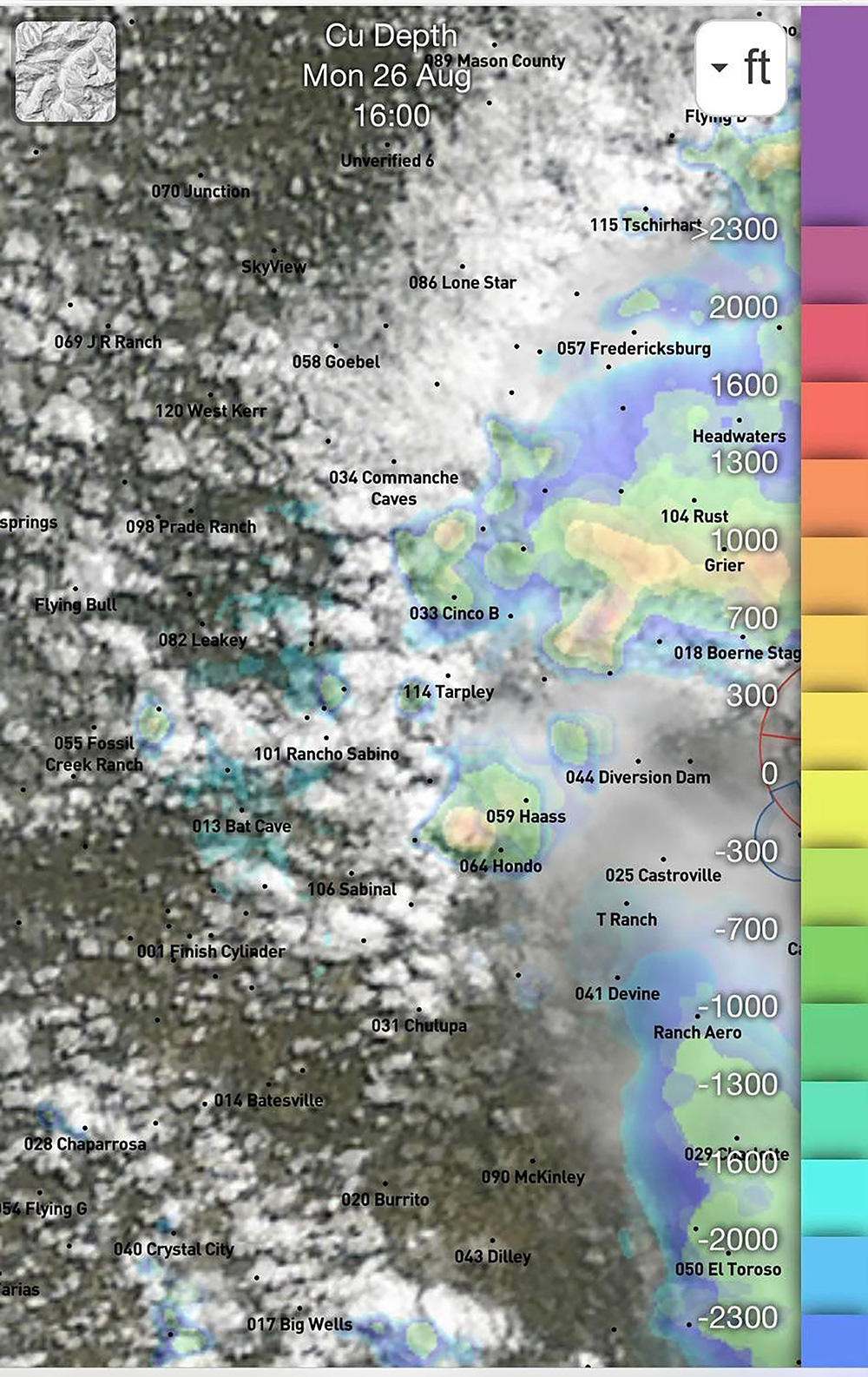
SkySight. satellite image showing a complex cloud pattern on 26 August. Lumpy came 3rd and Matthew 4th in 18m class.
Race 8 – 26 August – 4th Place
A complex day – big storms forecast for the afternoon, still a long task but fortunately an early launch. The storms looked to be a touch behind schedule to me, so I waited a bit longer and just as my gate opened I had the two Germans in 1st and 2nd whizz through the start. I gladly took the tow, as the relatively underdeveloped morning thermals were a bit hard to find.
They were kind enough to give me a few goes at leading out but it never lasted long – they're just too good as a pair.
Seems like they had a disagreement near the last turn and went in different directions – I liked the geometry better to the west and turned a little earlier than the rest there to bank the day and lower the risk of hitting the gust front on landing. As it was, I landed in 15G25kt crosswind, which is a non-issue in the JS3.
I was hoping to pick up some points on the French and march towards third, but they've got us, I suspect with a routing that utilised the gust front to get home. Maybe tomorrow is the day.
30 August – First Day Win at a WGC
I used EVERYTHING left in the tank today – no extra risk but maximum focus and energy. Nothing particularly special except for a honking final glide.
Unfortunately, no one above me made a major error so I'll still land in 5th overall, but a lot closer to the top. Weirdly (?), this is my first ever Day Win at a worlds.
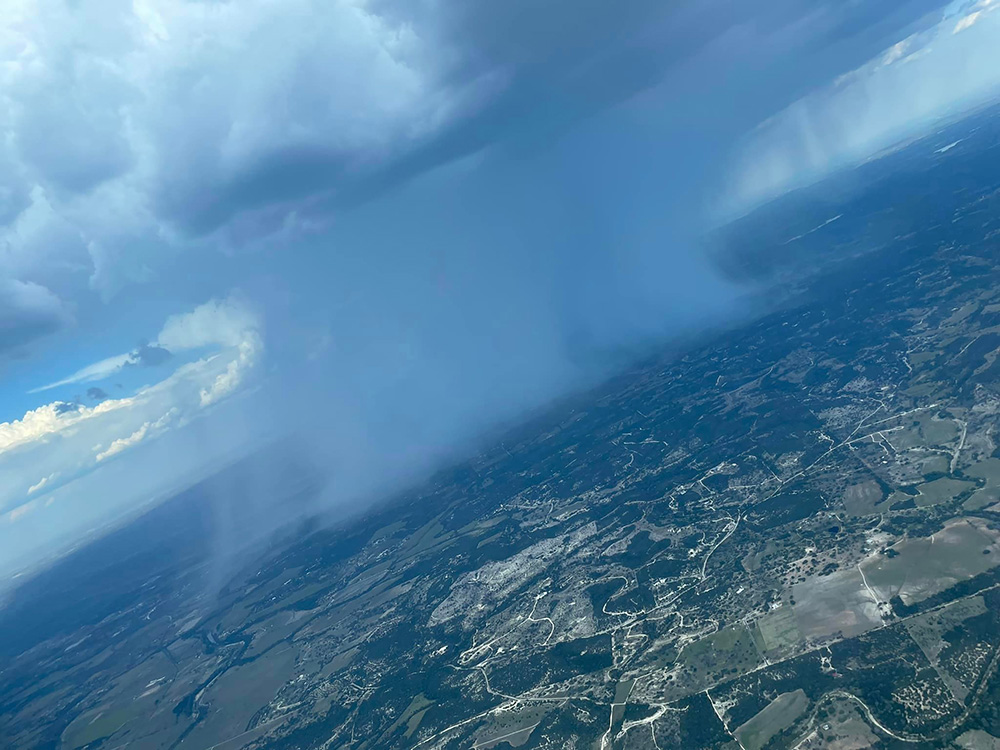
Keith Gateley
My Uvalde Texas gliding experience included nearly 80 hours of gliding, covering 7,500km of tasks.
The highlights include cumulus streets that allowed for fast and furious final glides. Our best lasted 38 minutes, covering 142km at 221kph without a turn. On one day, we found a difficult path around thunderstorms with rising air, sometimes in the rain, and on another we got a climb when we were so low that it seemed like the engine was our only option. In fact, we only needed to use the engine once, to get home on a day when no one in our class was able to complete the task.
Some other high points came with our two 1,000 point day wins, when we managed to hold onto overall 2nd place for 7 days and, of course, the achievement of finishing 4th place overall.
We met up with many friends from around the globe, and made new friends, leaving me with too many people to thank. Among the top contributors to this wonderful time I had was Adam Woolley, who was always focused and always smiling, even during the challenging times. This made our 6th competition flying in an Arcus M together.
Dylan Lampard, our crew, looked after us with such a high standard and always had a smile and encouraging words before each takeoff. I must also thank Ron Ridenour for allowing us to use his wonderful Arcus M and assisting with the crewing. That includes the crazy distance he drove between Chicago and Uvalde to bring the glider out and back again.
Of course, the rest of the Australian team, and our new American friends that were crew, host family, team captain and the numerous organisers and volunteers that put on this spectacular event – all of them deserve our thanks as well.

Lumpy Patterson winning Race 6 in 18m class
Lumpy Patterson
Race 2 – 19 August – 3rd Place
Jorgen and I started the day at 6.30am by prepping the glider with water ballast, batteries and DI. We felt much better doing this in the cooler air, and I reckon it was the best part of the day, watching the sunrise. Then we towed out over the scales and lined up in our assigned grid area.
Briefing was at 10 bells, and quite informative and quick, which was great. We then went to another room for an Aussie Team meeting where we discussed the day’s flight and looked at the weather in more detail.
The 18m task for the day was a 4-hour AAT with 420km as a min and 630km as the maximum distance. The tricky bit was navigating the blue holes that covered the first leg, and as we headed south the conditions got better and better. The key was pushing as far as you dare into the first sector, as it was much softer than the rest of the task. This was done to ensure we didn’t come in under time, even though we maxed out the rest of the task.
I feel privileged to be able to represent our country at this level and I set my self a goal to try and get at least one day in the top ten against these great pilots … tick.
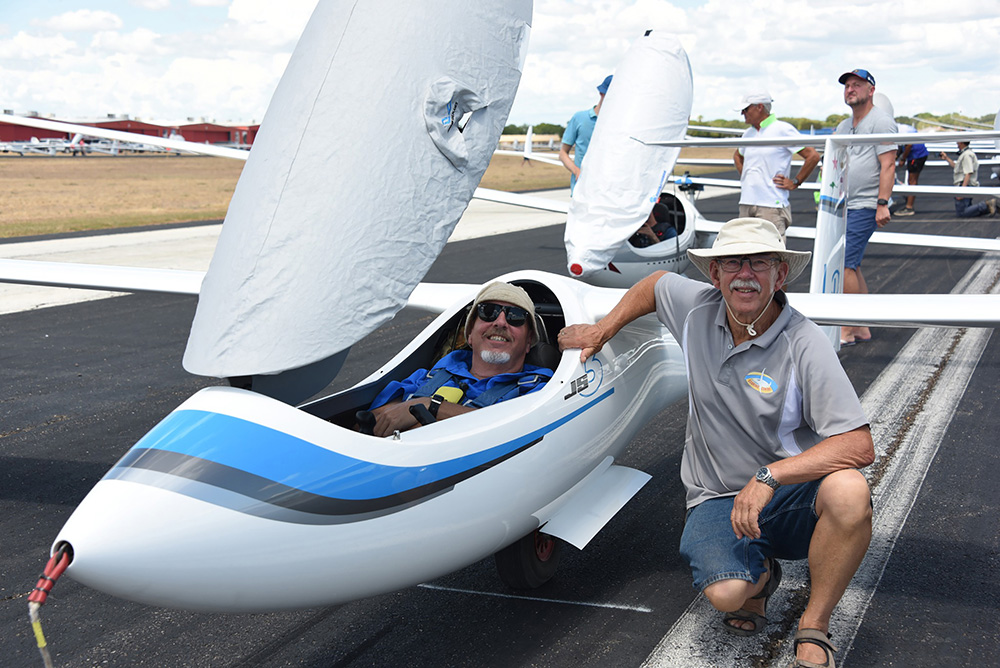
Lumpy Patterson the grid with his support crew Jorgen Thomsen from Denmark.
23 August – Day Win
Today was a 575km racing task, first heading southeast towards the ocean and towering thunderstorms, which had started very early in the day. Fortunately, the storm had died down by the time we got there. However, the high cloud that it had generated put the task area into shadow, cutting off convection and making things very, very soft.
It was interesting to see what the pilots’ strategies were as we headed out from the first turn. I noted a large gaggle had done a 180-degree turn after the turnpoint, heading back to the sunlight. I decided to head out on track towards turnpoint No 2, figuring I might as well glide on track as go backwards. I dumped some water to get down to a 56kg wing loading and headed off towards the lighter shadowed area.
Since there was a big lake on track, I decided I didn’t want to pass downwind of that and be low, so I chose a path upwind. As the sun warmed the ground, a few little cumulus started to pop on track and I could see the sea breeze starting to influence the sky with some good energy lines towards the last turn. I hooked up with a few other gliders at this point and ran with them to the last turn. We worked well together and made the most of the air, each taking turns to lead out.
We all turned the last turnpoint pretty much together and then it was about stringing some good lines home. I was very mindful of how quickly the day had closed down the day before and, still 200km from home, I was going to get high and stay high. This time we had a 15kt tailwind instead of on the nose. Now that’s a nice feeling.
The run home was good, even though we passed through large areas of blue, and the few clouds remaining provided 3 to 4kt climbs. I set off needing to find 1,000ft on the way home with MacCreedy on 3 – and unlike yesterday, I enjoyed this one!
To win a day at an event like this with the quality of pilots flying – it’s a dream come true.
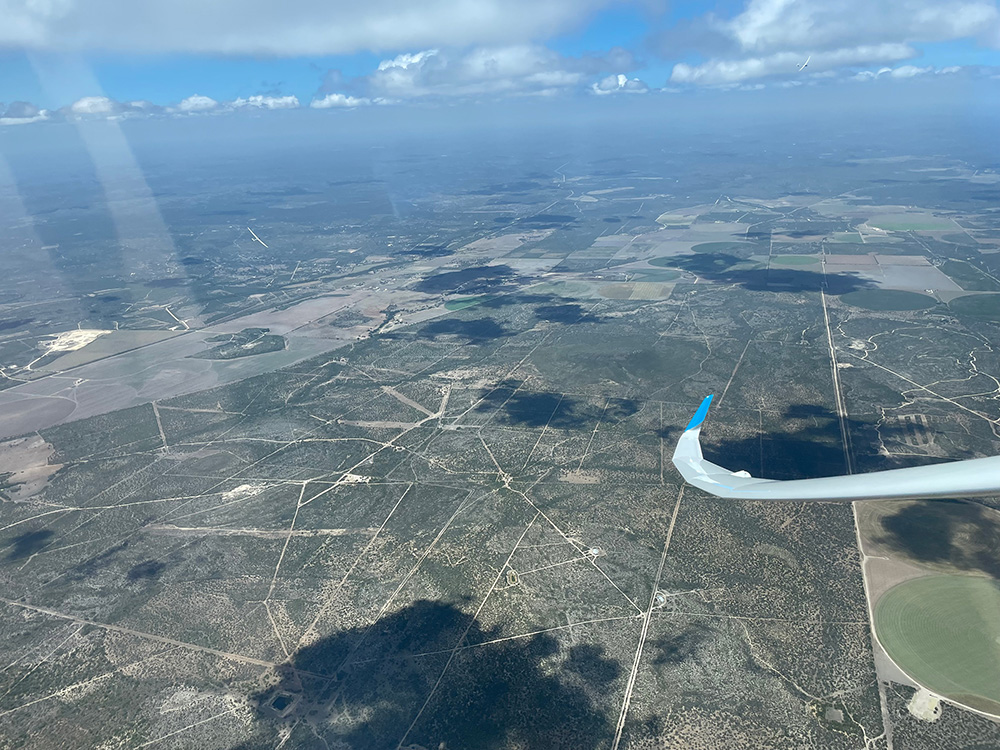
Race 8 – 26 August – 3rd Place
Today was a different routine from our past week’s flying. The call was made to hold briefing half an hour earlier and be gridded by 11am for an 11.30 first launch. Thunderstorms were forecast for the afternoon, moving in from the Gulf at quite a quick rate. The million dollar question today was – when? The pilots had different ideas on what that answer was going to be, and this was reflected in their start times and strategies.
The ability to get satellite pics on a semi-regular basis certainly does help, however, the phone service here in the air is somewhat infrequent. Plus, you’re really trying to predict the weather 3.5 hours in advance.
Most pilots went fairly deep into the first turnpoint, which was a little tricky because one-third of the circle was over the Mexican border, which incurred an instant 1,000 point penalty if you breached it. So, going as deep as you could is a better description.
The run south to the second turnpoint was pretty good, with the clouds almost lining up, not quite streeting but creating good energy lines. The climbs were between 4 and 6kts to about 5,500ft AGL on the into-wind leg. I went quite deep into this one, too, as my LX was telling me that I would need most of the distance available to complete the task without coming in under time.
Third leg was rather a hoot as the clouds got bigger and some started dropping rain. I could see the dust front out to the east working its way towards Uvalde. There was a big step down in the clouds as well. This is where the fun began as I was trying to find the best way to capitalise on the storm front after turning the final turn. If I got it wrong ... I’d be going into very heavy rain, but if I got it right, a good run home would be sweet.
I worked out what distance I needed in the last sector to come home at 165kph – since that was what I’d been doing for the last hour or so – and still be on time. Any slower meant being over time and thus a slower day speed.
As it turned out, I think I got it pretty right. After turning the final turn point, I only turned a few times, picked up 3,000ft on the way home and came in 11 seconds over time. Now, if I could just do this consistently...
Most of the field landed in a 45-degree crosswind as the storm front passed over. At the time, the wind was 20kts, gusting 25. Everyone did really well, all things considered, and I managed to sneak in another podium finish.
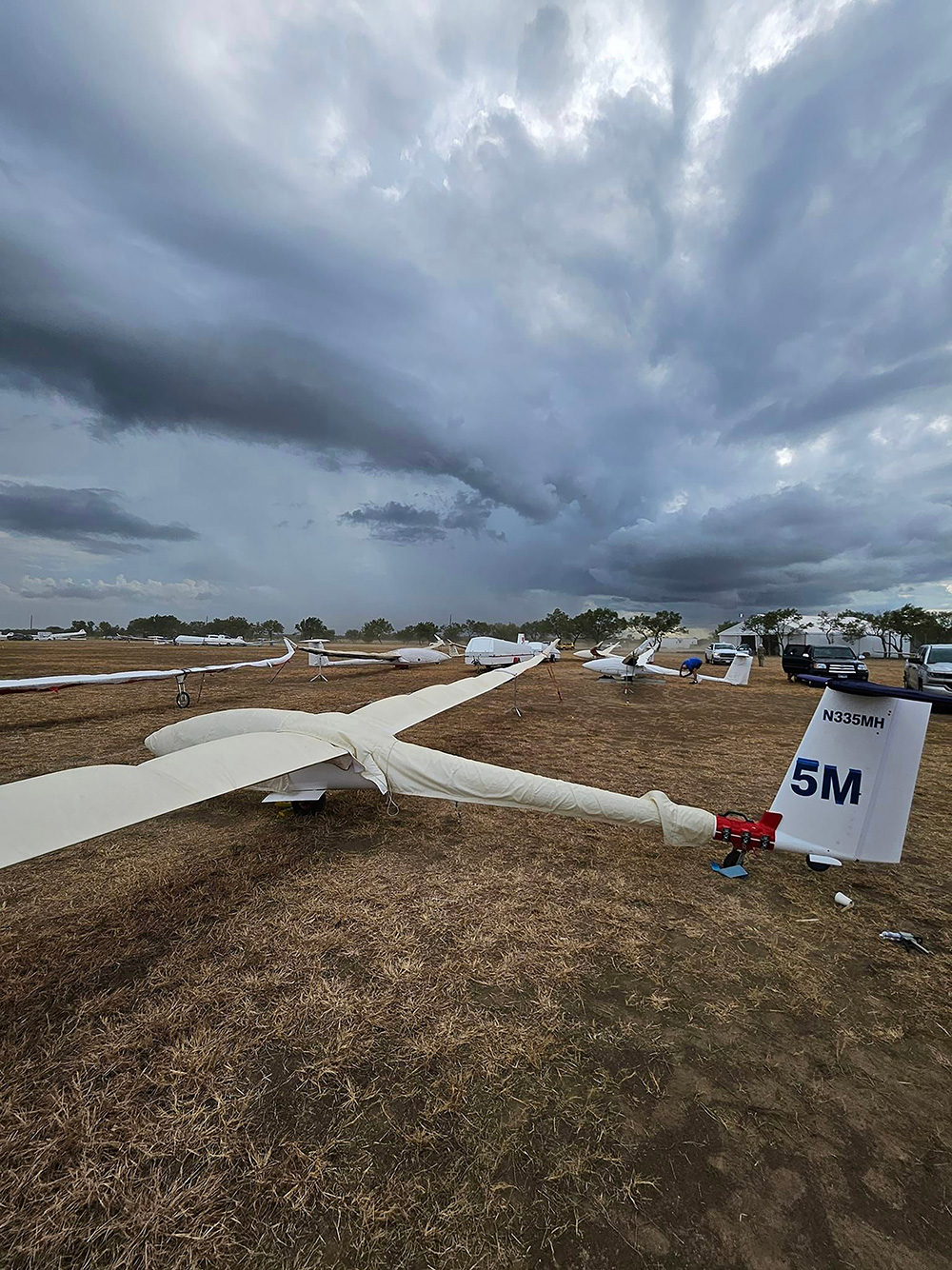
Matthew Scutter Wrap
Overall, I'm quite OK with my own result, which feels like I proved to myself that my 3rd place in the 15m class at WGC2020 was not just a fluke from a weak-weather contest, as I was one of the only pilots in a Diana 2. This contest was probably the most competitive field I have ever raced against, on top of a level playing field of aircraft and weather.
What Went Well
Strong weather – I am comfortable and experienced in strong weather after thousands of hours flying in Australia.
JS3 – I have about 400 hours of JS3 time now and am quite comfortable flying them. I was concerned about this glider in particular, given it had just had its tail reattached, but it flew straight and performed very well.
Crew – Supercrew Tim was a lifesaver. Having a licensed mechanic who knew gliders inside and out was a huge support, and Tim immediately stepped up into a vital part of the ground support while inflight, too.
SkySight – Uvalde is a tricky area to forecast, with the streets mixing the moisture further inland than models understand, but SkySight gave me an edge. Inflight satellite imagery was a HUGE advantage on the thunderstorm and sea breeze days.
What Went OK
I've had lucky and unlucky contests, and this was neutral to mildly unlucky. No magic opportunities presented themselves, no lightning bolts of luck, but I was also never caught out by anything catastrophically bad either.
Super consistent flying – My strategy that I've been working on for a few years now is just to be insanely safe, reliable and consistent in my decision-making, never take risks, never get low, never get slow, and let others make mistakes while I float to the top. The apple cart was only slightly upset with one major strategy error that cost me 200 points.
What Went Poorly
Fatigue – The intense heat (40°C-plus every day), coupled with working hard on preparing the glider in the practice period, left me tired before the start of the contest, and I slowly fell off the horse as the days went on, leading to a major error that I so clearly knew not to make, costing me at least a couple of hundred points on the day before the rest day.
600kg – I was so unprepared for handling the glider at 600kg. I had been fooled into a false confidence in my glider handling, having won several European contests with it, and just assumed I'd cope with 600kg without much more practice. The glider feels like an LS8, something you can step into and win, but it's deeper than that. By the end of the contest flight analysis showed I was only handling the glider in thermals as well as the median pilot, let alone the top pilots. I have learned so much about cruising, pulling and thermalling the JS3 this competition.
Not familiar with the site – My practice period was shortened against my plans due to container scheduling, and the practice I did manage was disturbed by a fault, making it a pure glider until Contest Day 1.
I didn't anticipate that so many tasks would go deep into the late evening, approaching sunset, and was repeatedly surprised by the end-of-day shutdown. The day always starts slower than the sky suggested, slowly building up to the ‘Hour of Power’ at 5 – 6pm, when every cloud has 10kts under it. Then it's like a car crash, extremely rapid shutdown between 6 and 6.30pm, with most clouds producing 2 – 3kts but a few lucky 6kt climbs until 7pm, which could usually only be found by a gaggle hunting together.
Pair flying – I did not anticipate pair flying would be advantageous in Uvalde. Typically strong conditions give little advantage to pairs, but almost every cloud in Uvalde was a multi-core thermal, and having teammates to help hunt for the cores was a clear advantage for the German and French teams, for which I was very jealous.
GPS failure – I cooked one of my only 'lucky' days when I lost the GPS antenna on my primary navigation and FLARM.
No current comp practice – I had no high-level 1,000 point contest before this event in the year prior, and it took me a while to get in the flow again.

Geoff Brown on the grid at Uvalde in Open Class.
Ronald Tabery - Team Captain
What a privilege for Gena and me to be part of Team Australia! Our goal was to create an environment that made for successful racing at Uvalde and provide insights, whether strategic, terrain-related, organisational or logistical. It is safe to say that Team Australia pilots and crew are quick students and caught on immediately. Everyone - pilots and crews - maintained high standards and discipline necessary to win.
The Pilots
Matthew Scutter Sensational only begins to describe Matt’s capabilities. When he is ‘on’ there are none better. Perhaps the best example of his prowess was the big win on the final day (151.72 kph), a 3% margin over the nearest competitor. That kind of margin is rare, particularly at a WGC.
Lumpy Patterson Australia’s most enthusiastic competitor was on top of his game for the biggest race of his life - so far. And like his 18m classmate, when he was 'on' there were none better. Three days in the top 3 with a first-place finish on day 6, demonstrates high-level consistency that said to the world, “I belong in the big leagues.”
A BIG aside to Lumpy’s story is that he did everything right to prepare ahead of time, shipping his glider to arrive three-weeks early for practice ahead of the race. The only problem was that his container arrived three-weeks late. Only three DAYS of practice were possible at an unfamiliar site before the officials started keeping score. Imagine what might have been with more familiarisation flights.
Adam Woolley More than proficient and professional, Adam has honed his skillset to become master of the mechanics, technology and art of soaring competition. Few, if any, are more at home in the cockpit than he. To prepare for each race day, Adam consumes information to form analytical interpretations, then continues to update in-flight decisions in real time.
Keith Gateley Adam and Keith placed in the top ten on 10 out of 11 days. I credit this in part to Keith’s unflappable co-piloting. There is no doubt that their in-cockpit decisions were informed by level-headed thinking, made possible by Keith’s ability to filter out chaos and return their collective focus to tasks that matter. This is an underrated aspect of successful competition strategy, and Keith is a master at decision making.
Geoff Brown Perhaps the most distinguished airman in the entire field of pilots at the WGC was Air Marshall Geoff Brown, retired senior officer of the Royal Australian Air Force and former Chief of Air Force. Geoff favoured early starts, which frequently put him out front during long tasks, sometimes in first place until late starters gained ground. His approach to racing was deliberate and conservative, prioritising personal safety.
In this grueling competition of long, hot days, Geoff was mindful of the toll racing can take on the pilot. He was first to admit that he was there to learn, and his performance throughout the competition demonstrated achievement of his goal.
Team Hosts Competitions at Uvalde have a storied history of interaction with Uvalde citizens. Each team is assigned a local host. Resulting friendships might be transient or lasting - one member of the French delegation from a prior WGC made a connection that resulted in marriage and several children. Lucky for Team Australia, our team hosts were Melissa and Craig Garnett, the most hospitable couple imaginable. Their outreach was more than flag waving. They invited the entire team to their wonderful estate and were graciously flexible to account for long days in the air and at the field. They also came to the airport to lend a hand on days that they were not otherwise looking after the team’s needs. Craig is owner and chief editor of the Uvalde Leader-News, and an award-winning journalist. He is also a pilot, and was lucky enough to fly several hours in an Arcus with the daily sniffer, experiencing first-hand the most beautiful air sport.
The Weather ‘Typical’ is perhaps the worst term to describe any contest’s weather patterns. Each day is unique, although it may be said that day-to-day similarities exist, and by that yardstick, this year was atypical. For example, Day 10 was canceled for 18m and Multi-seat classes. Only the Open class was launched early enough to warrant a task. Storms grew rapidly and obliterated a lot of the task area. The only finisher was Claudio Schmidt (Brazilian, flying the beautiful Nixus) whose daily habit was to be the first starter - on that particular day, it paid off.
Typical at Uvalde is often described as a clear start to the day, shortly followed by low overcast until mid-morning, gradually breaking into parallel streets about 2,000ft AGL that rise to 3,500ft by noon. Finally, scattered cumulus rise to 6,500ft to 7,500ft during the course of the day, and sometimes realign in streets. High cross-country speeds are typical. This year saw less streeting and slightly higher bases. It is hard to feel sorry for pilots when typical winning speeds in all classes were 120 to 160+ kph.
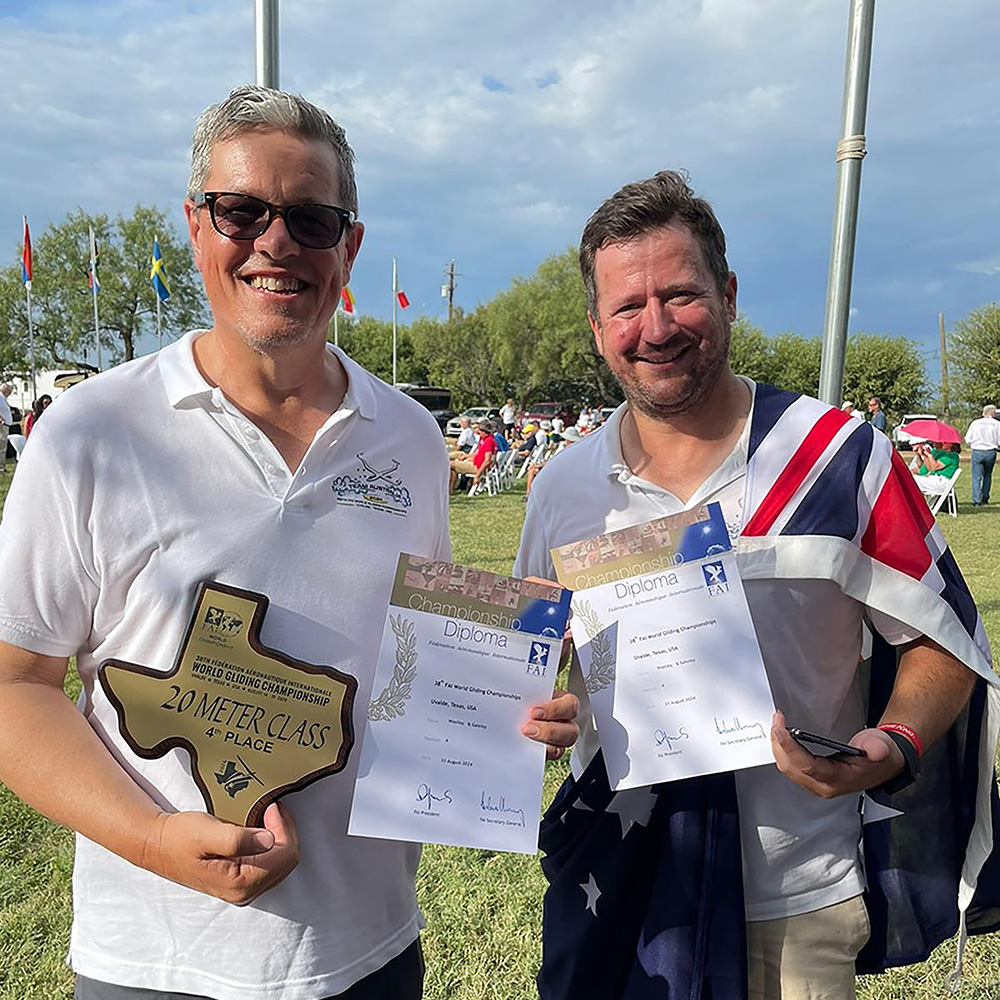
Keith Gateley and Adam Woolley with their diplomas for achieving 4th place in 20m Multi-seat class.
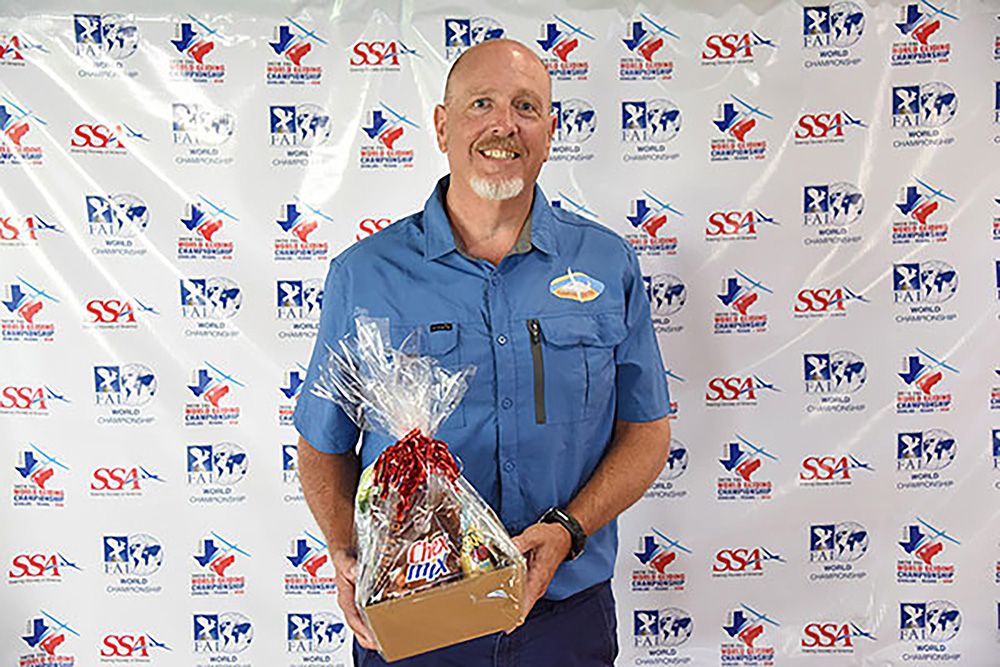
Lumpy Patterson on the podium. He took 3rd place on two days and 1st place on one.
WGC 18m, Open, 20M Uvalde Texas
18 - 30 August 2024
18M Class
1 GER Stefan Langer AS 33 Me 9,843
2 GER Simon Schröder Ventus 3e 9,636
3 FRA Christophe Abadie JS3 9,592
5 AUS Matthew Scutter JS3 9,408
16 AUS Lumpy Paterson JS3 8,678
20m Two Seat
1 USA Arnold & Striedieck Arcus M 9,616
2 POL Rubaj & Matkowski ASG 32 Mi 9,552
3 AUT Lutz & Janowitsch Arcus M 9,499
4 AUS Woolley & Gateley Arcus M 9,484
Open class
1 GER Felipe Levin EB 29R 10,887
2 GER Michael Sommer EB29R 10,782
3 FRA Laurent Aboulin JS1C 21m 10,485
16 AUS Geoffrey Brown JS1C TJ 21m 7,176
Full results at soaringspot.com. and at wgc2024uvalde.com































